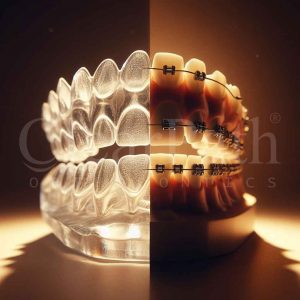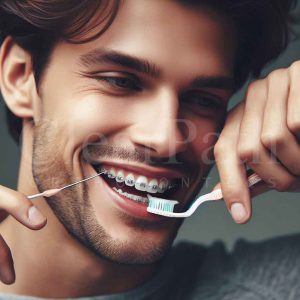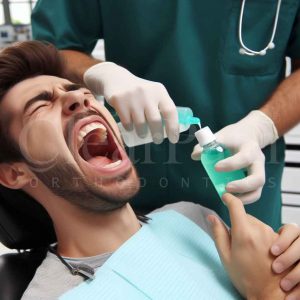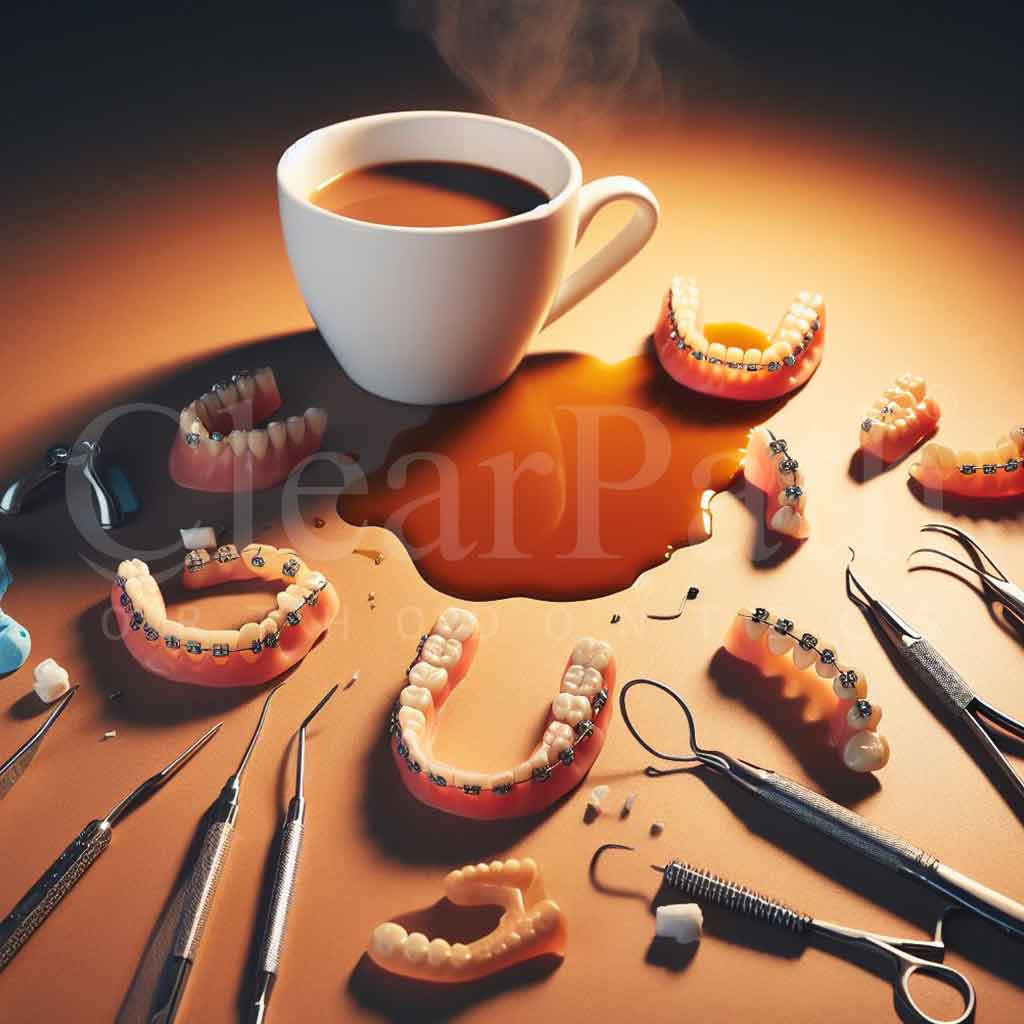When you’re deep in the world of orthodontics as a dental brace or clear aligner wearer, there are a few adjustments to your daily routine that you need to make – particularly concerning what you put into your mouth.
But don’t worry 😄.
This does not mean you have to bid farewell to your comfort foods or that cherished cup of morning Joe ☕.
Instead, it’s all about striking a balance – moderation, careful choices, and some smart strategies to ensure your teeth straightening device and overall oral health remain in tip-top condition.
Table of Contents
ToggleThe Snag with Coffee and Braces
Now, coffee – like tea – is the morning lifeline for many. But while it’s an essential pick-me-up, it can also raise hygiene and problematic dental disease 😬 concerns for people with braces.
The good news is that you don’t have to banish the beverage from your life entirely. What you do need to do, however, is be mindful of how and when you indulge.
To savor the treat safely while wearing braces, you’ll need to control your intake and follow a set of necessary precautions (what we’ve discussed below).
The Clear Aligners Advantage – and Twist

If you’re sporting clear aligners, though, your relationship with coffee is friendlier. This is because they are removable: a dental appliance feature that, unlike traditional braces, opens up a world of culinary delights for wearers.
It’s vital to remember to remove them before you enjoy your sip, though, as these transparent braces are susceptible to staining and warping. Also, you are recommended to properly brush and floss before putting them on again so they remain clear and hygienic.
What, Exactly, Makes Coffee Bad for Braces?

Coffee, that rich, dark elixir that has been immortalized as part of the urban daytime protocol, has a hidden dark side when it comes to braces and teeth. Over time, it can cast its staining spell on your dental hardware and enamel.
The culprits behind this effect are the drink’s tannins and chromogens, plant compounds that cling to your tooth enamel, and the brackets of your braces.
If you sport ceramic or clear braces designed to blend with your natural tooth color, the stains from your daily coffee ritual can be particularly conspicuous (a problem that can be easily alleviated, as mentioned, through proper brushing).
But the story doesn’t end there.
Coffee is a villain that weakens enamel and the adhesive that securely holds your braces in place. And if that’s not enough, it can even gnaw away at the glue bonding the brackets to your teeth, causing them to loosen or, in some unfortunate cases, fall off 😩.
The impact of coffee on teeth with braces – and your dental environment, in essence – can be summed as follows:
| COFFEE WOES | IMPACT ON TEETH & BRACES |
|---|---|
| Staining | Coffee owes its color and flavor to tannins, natural compounds that can transform your teeth and braces into a canvas for unsightly yellow or brown stains. This not only affects your smile but can also undermine your confidence and make cleaning your braces a real chore. |
| Tooth Decay | If you’re the type who likes to sweeten their coffee, you may be nurturing the perfect environment for tooth decay. With braces, these added sugars create little cozy nooks and crannies for plaque and bacteria infestation, significantly increasing the risk of cavities. |
| Sensitivity | Braces often render your teeth more sensitive, and the temperature extremes in your coffee can take that discomfort up a notch. |
| Corrosion | Coffee wears an acidic crown 🫅, and its reign can lower the pH level in your mouth, jeopardizing the integrity of your enamel. Enamel is your teeth’s fortress, shielding them from decay and sensitivity. When it erodes, your teeth become more susceptible to cavities and discomfort. Plus, the acid in coffee isn’t doing your metal wires and brackets any favors either – it weakens them, making them less effective and more prone to breaking. |
How Coffee Affects Various Types of Braces

Various types of braces are utilized in orthodontic teeth-straightening treatment, each with its unique considerations when it comes to coffee consumption.
Here’s the breakdown.
- Traditional Metal Braces: Traditional braces are typically fashioned from metal components that can be susceptible to coffee-induced staining, making them more conspicuous. Coffee’s acidity can potentially compromise the enamel surrounding the metal brackets.
- Ceramic Braces: Ceramic braces are designed to be less noticeable than their metal counterparts, yet they remain prone to coffee and other beverage staining. The enamel encircling the ceramic brackets can also be affected by the acidity of the drink.
- Clear Aligners (e.g., ClearPath Aligners): Clear aligners are crafted to be removable, as mentioned, granting you the liberty to take them out before partaking in coffee or any other treat. This flexibility makes clear aligners an appealing option for those with a penchant for a diverse dietary experience and a love for coffee.

Therefore, for individuals who appreciate culinary variety (a lot of people who not only hail from Eastern cultures) and cherish their coffee, clear aligners can be an excellent choice to seamlessly integrate teeth alignment therapy into their lifestyle without having to compromise the fun part 🙌.
So, How Do You Drink It Safely With Braces?

Teeth/gum sensitivity becomes a common issue to contend with when you’re stuck in the world of conventional braces.
But there are things you can do to make the ordeal bearable – especially if you can’t let go of your coffee fix.
Consider going for the following ‘band-aids’ if you’re struggling with the braces sensitivity monster:
- Toothpaste for Sensitivity: A specialized toothpaste designed for sensitive teeth should be your go-to. These toothpaste varieties, containing mild analgesics, work wonders in reducing the discomfort triggered by hot or cold beverages, such as that cherished cup of coffee.
- Desensitizing Mouthwash: Another nifty solution lies in certain mouthwashes specifically formulated to ease tooth sensitivity. A quick rinse with one of these after your indulgence can provide some quick, much-needed relief.
- Limit Temperature Extremes: If your teeth tend to be on the sensitive side naturally, consider avoiding your coffee at extreme temperature ends, whether scalding hot or ice-cold. Opting for a more moderate drink temperature can significantly minimize any discomfort you might experience.
Impact of Coffee Brewing Methods on Staining

For coffee enthusiasts, the art of brewing the cuppa is part of the experience. What might surprise you is that the choice of brewing method not only affects the flavor but also how likely your coffee is to stain your teeth and orthodontic hardware (like braces).
French Press
The French Press is known for its simplicity and its ability to preserve the natural oils in coffee beans. This is what gives the resulting brew its rich, full-bodied taste. It’s also one of the methods that can lead to significant teeth and brace staining. During the bean grounding and extraction process, the natural oils, which contain compounds that can discolor your teeth and braces, are released into the coffee.
As a result, if you’re enjoying French press coffee regularly, the shot will be more likely to leave its coloring mark.
Espresso
This is a more concentrated brewing method. It involves forcing hot water through finely ground coffee beans for a short period.
But here’s what’s interesting:
Despite its strong flavor, espresso is (paradoxically) less likely to stain. The quick brewing time and limited contact with coffee grounds result in a brew with fewer staining compounds.
As a result, espresso can be a more teeth-friendly choice in terms of staining potential.
Protecting Your Braces from Stains

Given the undeniable concern of staining, it’s worth diving into some practical strategies to shield your orthodontic appliances from coffee-induced discoloration. If you’re using braces, however, note that none of these approaches will promise 100% safety from coloration.
Here are some steps you can consider:
- Brush Your Teeth Well: Make sure you brush your teeth every time you drink coffee and use toothpaste that has fluoride in it. Fluoride can help protect your enamel from the acid in the drink. Also, don’t forget to clean around your brackets and wires because that’s where the stains can hide.
- Floss Every Day: Flossing may seem hard with braces, but it’s very important that you commit to it. This can help you get rid of any food bits or coffee residue that are stuck between your teeth while also preventing staining and cavities.
- See Your Dentist or Orthodontist Regularly: Sometimes, brushing and flossing are not enough to remove all the stains and plaque from your braces and teeth. That’s why you need to visit your dentist or orthodontist often so they can give you a professional cleaning. These specialists use special tools and techniques to make your braces and teeth shine.
- Ask About Whitening Products: If you want to whiten your teeth while wearing braces, you should talk to your orthodontist first. They can tell you which whitening products are safe and effective for your condition. Some products may not work well with braces or may cause sensitivity or damage.
The Alternatives to Coffee That You Can Explore

If the prospect of sipping coffee with braces feels too daunting or inconvenient, fret not – there are some delightful alternatives that can satisfy your caffeine cravings without the potential drawbacks:
Tea
Steaming cups of tea make for an excellent substitute. They are generally less acidic and less prone to staining than coffee, especially if you opt for herbal or green tea varieties. Nevertheless, it’s wise to heed the same precautions you would with coffee since tea does contain tannins.
Milk
Milk not only provides a dose of calcium and protein to fortify your teeth and bones but also boasts a neutral pH level. This neutrality means it won’t harm your enamel or corrode your braces. Sip it plain, or experiment with flavors like vanilla or a dash of cinnamon.
Water
The unsung hero of beverages – water (good, old, and humble). It’s a boon for your teeth and braces, offering hydration, mouth cleansing, and pH level equilibrium. With zero calories, sugar, or caffeine, it’s a wholesome choice for your overall well-being. Feel free to enjoy it as is 😉, or add a touch of zest with lemon or cucumber slices.
Iced Coffee and Cold Brew
If coffee remains your true love, consider making a shift to iced coffee or cold brew. These cooler alternatives are generally gentler on your teeth and less prone to staining than their scalding-hot counterpart. What’s more, controlling the sugar content reduces the risk of tooth decay.
Decaffeinated Coffee
For those who adore the taste and ritual of coffee, decaffeinated coffee offers a milder option. With less caffeine, it’s less likely to trigger sensitivity. But staining is still a problem, of course.
Milk Alternatives
If you fancy a dash of creaminess in your coffee, non-dairy alternatives like almond or oat milk can come to the rescue. They not only cater to your taste buds but also treat your teeth and braces with relatively more kindness.
Can You Drink Coffee With Clear Aligners?

Yes!
Clear aligners, those removable, ‘invisible’ plastic trays that snugly fit over your teeth and work their magic in gradually shifting them to that coveted straight position, grant you much more freedom in your eating and drinking choices, including your coffee breaks.
Just be sure to remove them before taking the palate thrill.
You know by now that coffee leaves a mark.
Additionally, the heat from the drink can spell trouble by warping your clear aligners through the high temperatures, potentially affecting their fit and treatment efficacy.
So, for a catchy mnemonic (remembering device). the coffee-and-clear-aligner dance has to go something like this:
Off goes your clear aligner before you savor that aromatic brew 💃.
Afterward, give your mouth a good rinse with water, and don’t forget to brush your teeth.
Once your coffee indulgence is complete, your clear aligners can make their triumphant return.
With Braces or Aligners, Commit to Regular, All-Round Cleaning
Regular flossing and brushing are important.
To prevent staining and discourage the growth of unwelcome bacteria, make a habit of cleaning your clear aligners with a mild soap or a cleaner specifically designed for this purpose.
Understand that while your orthodontic dental alignment journey is a temporary phase, the health of your teeth is a lifetime commitment.
Bottom-Line
Coffee can be a big stain on your braces, aligners, and teeth.
But there are ways to mitigate some of its impact.
The least bothersome teeth straightening appliance option – if you want to retain some semblance of a coffee-filled life with other delicacies – would be clear aligners, though.
So, if you’re considering an effective dental alignment treatment to offset a lot of the trouble with braces and more aggressive therapy options, you’re best bet would be to get them.
And if you’re currently using braces and looking to transition to transparent aligners, here’s the quick, easy remedy:
Just fill out the form below ✍️ – and our friendly customer service reps will connect you with our expert panel of certified orthodontists.
They’ll get you started on your ClearPath invisible aligners in no time! 🤓
FAQs About Coffee and Braces
Q1: What are the different types of braces, and how do they react to coffee?
A: There are several types of braces available, each with its unique way of responding to coffee. Traditional metal and ceramic braces are more prone to staining, while clear aligners offer greater flexibility as they can be removed before consumption.
Q2: Why does coffee stain teeth? What’s the science behind it?
A: Coffee’s ability to stain teeth is rooted in science. This staining is attributed to compounds known as tannins and chromogens. Tannins bind to tooth surfaces, while chromogens are responsible for the coloration. Together, they create the familiar coloring effect.
Q3: Is it important to stay hydrated when drinking coffee with braces?
A: Staying adequately hydrated while enjoying coffee is essential. The beverage has a dehydrating effect on the mouth, which can heighten the risk of staining and other oral concerns. Hydrating with water helps maintain oral moisture.
Q4: Can the method of brewing coffee affect its staining potential on braces?
A: Absolutely, the method of brewing can influence how the drink interacts with your braces. For instance, brewing methods like the French press can release more staining compounds, while espresso, due to its shorter brewing time, is less likely to cause staining.
Q5: How frequently should I schedule dental appointments while drinking coffee with braces?
A: Regular dental and orthodontic check-ups are recommended at six-month intervals. These appointments are crucial for addressing any coffee-related issues and ensuring the smooth progression of your orthodontic treatment.
Q6: Do you have any real-life examples of individuals who successfully managed their coffee consumption with braces?
A: Of course, there are individuals who have effectively navigated their consumption habits with braces. Their experiences highlight that, with mindful consumption and moderation, it’s possible to enjoy the drink without compromising orthodontic treatment.
Q7: What tips can you offer for effectively cleaning braces to prevent staining and plaque buildup?
A: Maintaining excellent oral hygiene is key. Regularly brushing your teeth, including around the braces, and thorough flossing help remove food particles and stains. Employing orthodontic-specific tools can further assist in maintaining oral cleanliness.
Q8: When is the ideal time to enjoy coffee with braces, and why is post-coffee brushing important?
A: The most suitable time to enjoy coffee with braces is during or immediately after a meal. This minimizes the duration the drink interacts with your teeth. Post-consumption brushing is crucial to eliminate potential staining agents and uphold oral hygiene.
Q9: Are there specific foods that should be consumed sparingly when enjoying coffee with braces, and why?
A: It’s advisable to limit the consumption of sugary or acidic foods when enjoying the beverage with braces. These foods, when combined with the drink, can contribute to staining and tooth decay.
Q10: How can I adjust my dietary habits to reduce the impact of coffee on my oral health?
A: Adjusting dietary habits involves reducing the intake of sugary and acidic foods and upholding good oral hygiene practices. These measures can help minimize the impact of coffee on your oral health while wearing braces.











